secondary title
Parachains are disrupting the status quo
From a very macro perspective, our world and the various systems that make up the world are becoming more and more complex. It's easy to get lost in the details like regulation, oversight, and various paperwork.
This is the crypto world and our motivation for doing Polkadot. Our ultimate goal is to allow people to conduct transactions more fairly and clearly. Allow people to choose to join certain rules and collaborate with each other. Let people focus on what is really important and meaningful, instead of wasting time in complex bureaucracies and systems. The crypto world eliminates a lot of inefficient organization and collaboration.
Parachains are the realization of the last decade of blockchain development, both technically and philosophically.
Some things have been talked about for a long time, but the paper is not reality, the reality is what the code is executing. This is our goal, and the parachain is actually the real realization of the whole process.
Parachains will disrupt the way the networked society works
Broadly speaking, what you can do with parachains is actually disrupt the way we have interacted with the Internet so far, which means changing the way we transact, build, organize and govern.
In the past few years, we have seen a lot of changes in transactions, payments, finance, deposits, ownership and more.
But beyond that, we'll have different types of entrepreneurs, business models, ways to fund teams, ways to interact with other builders, etc. There will be new interfaces, libraries of economic primitives, cryptography, etc. None of this would happen without decentralization of truth and trust.
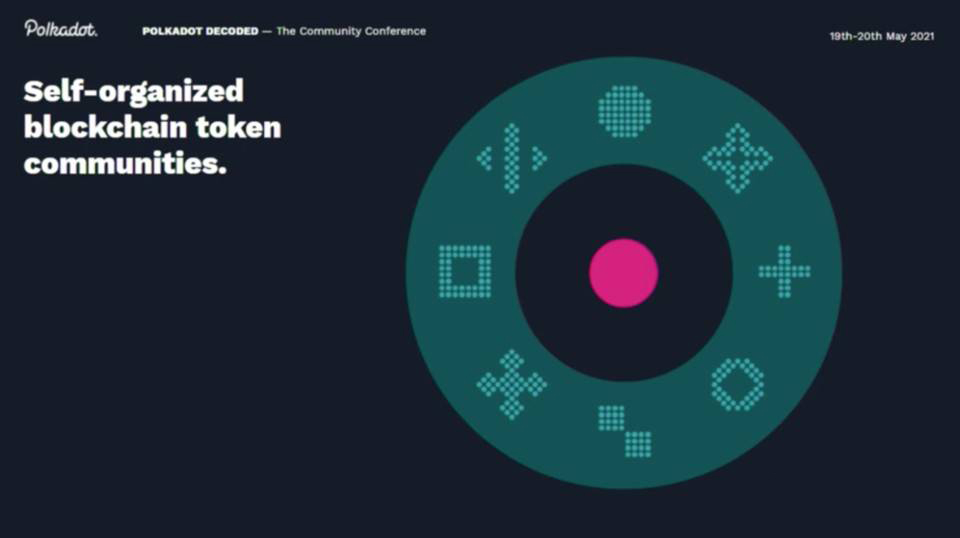
We allow everyone to come together, allow the community to organize itself, govern itself, and have clear binding rules on how to upgrade. I think Polkadot itself is an excellent example of autonomy. Some projects also have their own governance processes and governance tokens. Autonomy is underway from the smallest projects to the largest.
I find the concept of "self-organizing blockchain token community" very interesting. Because it is a concept native to the Internet, people from different classes, backgrounds, sources and regions organize around a common goal or principle. The diagram here shows that different groups of people from all over the world are organized around Polkadot.
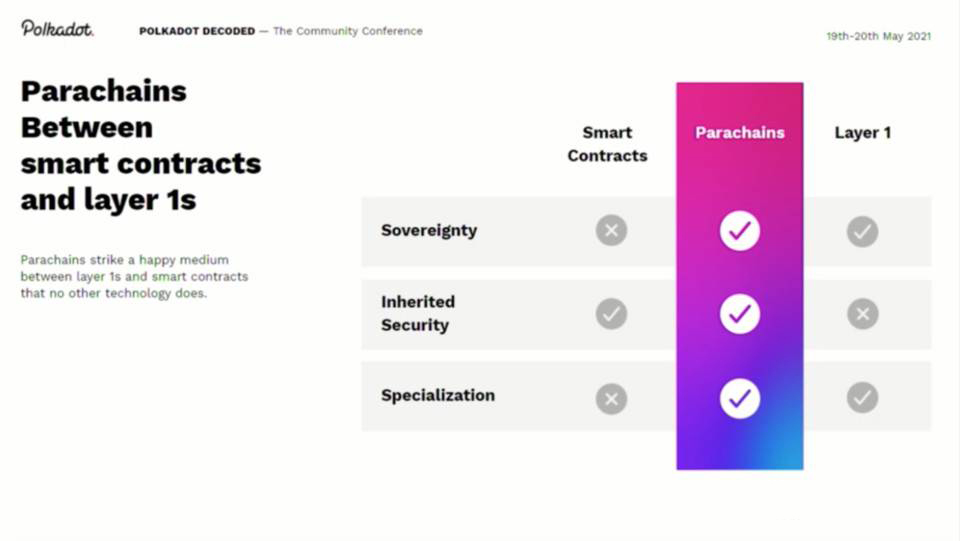
Parachains, Layer 1 Blockchains and Smart Contracts
Parachains are disrupting all existing blockchain technologies, i.e. all existing Layer 1 and smart contracts.
We have three metrics: Sovereignty, Inherited Security, Professionalism.
Sovereignty refers to how an object controls its own destiny. Smart contracts are greatly constrained by the system they belong to.
Inherited security refers to whether or not you need to muster your own set of validators. As a developer, do you need to worry about economic security when you build systems, making your systems large enough to be difficult to attack.
Specialization refers to the ability to provide solutions adapted to a particular problem domain. The more specialized you are in a certain field, the more efficient your solution will be, and the more people will be able to use it to transact.
We try to make the parachain meet these three indicators at the same time, but the current Layer 1 and smart contracts cannot.
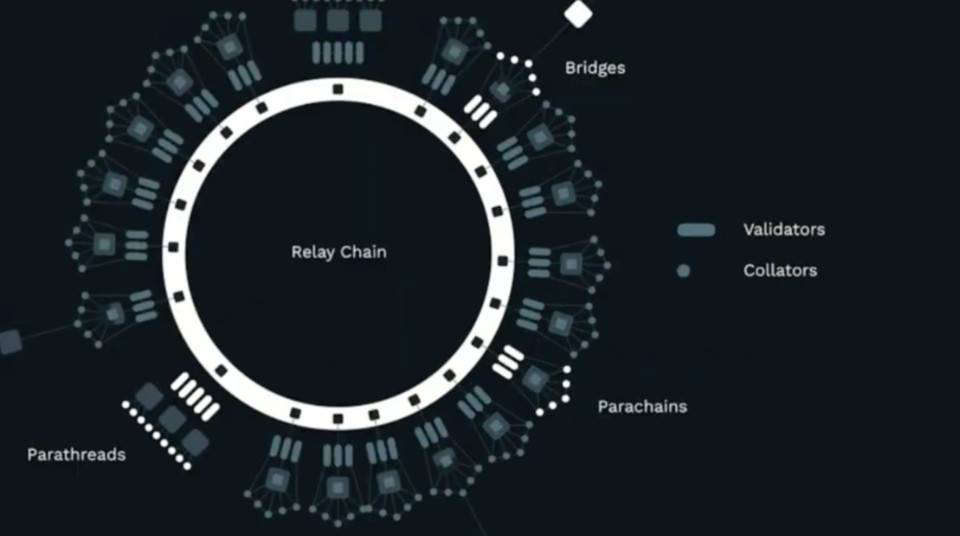
Polkadot architecture
If we take a closer look at Polkadot's architecture, in this picture, we can see how Polkadot works like this. There is a relay chain in the center, and there are many parachains protected by the relay chain, and each parachain has its own verifier and collector. Some of these parachains are bridges to other networks. There are also parathreads at the bottom, another type of parachain with a different scheduling mechanism.
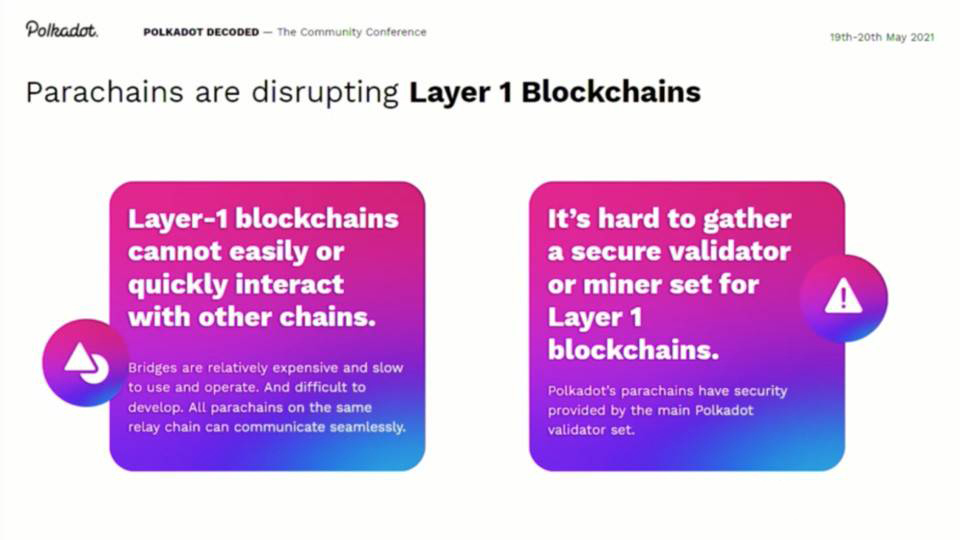
Parachains are disrupting smart contracts
A smart contract platform is too general for most use cases. You can only use very rough instructions like adding a number, subtracting a number, and so on. If you want to use it to create anything more complicated, you will find that its efficiency is very low, which mainly manifests itself in gas fees, because every addition and subtraction is charged, no matter what calculation you do, it will cause gas fees The superposition makes the efficiency become lower and lower.
With parachains, you can focus on your usage scenarios. You can have a transaction dedicated to storing files, a transaction to collect rent, and so on. This is more self-sufficient than if you had a million different little instructions.
Another key difference between parachains and smart contracts is that parachains are proactive rather than reactive.
The way smart contract frameworks work is that they respond to events that are submitted to the chain as transactions. But you can’t write a smart contract that says “wake me up in a year to do this work”, or say “I want to do something every time a block comes out”.
And as a developer of a parachain, you have this kind of control, and you can schedule a certain logic to be executed at a certain time or block height.
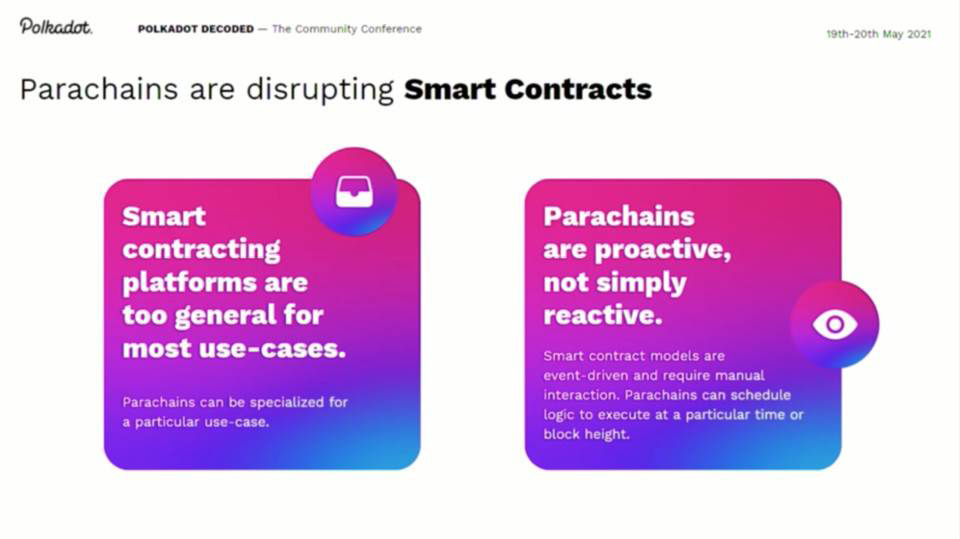
Parachains are breaking Layer 1 blockchains
Mainly because the parallel chain improves the convenience of communication. Layer 1 blockchains cannot effectively bridge each other. Although they can be bridged, there will be two sets of consensus systems and two sets of validators in the end. Also, proving to one chain that another chain has confirmed a block and accepted a transaction is a messy affair, often involving lags and delays.
Another point is that when you build a parachain, since this parachain is part of the Polkadot consensus system, you don't need to call your own validator set or miner set to ensure your security. Instead of amassing billions of dollars, you are responsible for security, ensuring your chain cannot be taken over or 51% attacked. This is a good advantage for teams with innovative ideas but not necessarily the ability to achieve economic security.
secondary title
Parachain is a technology
Parachain as a technology, what exactly is it? How does it work?
Fundamentally speaking, parachains are the execution core of Polkadot. Almost any type of transaction, except for something very important to the root of Polkadot, such as balance, Staking, governance, etc., runs on the parachain.
All smart contracts, file storage, oracle logic, etc., happen on the parachain. The parachain is where all the work in Polkadot's decentralized system takes place.
What is a parachain?
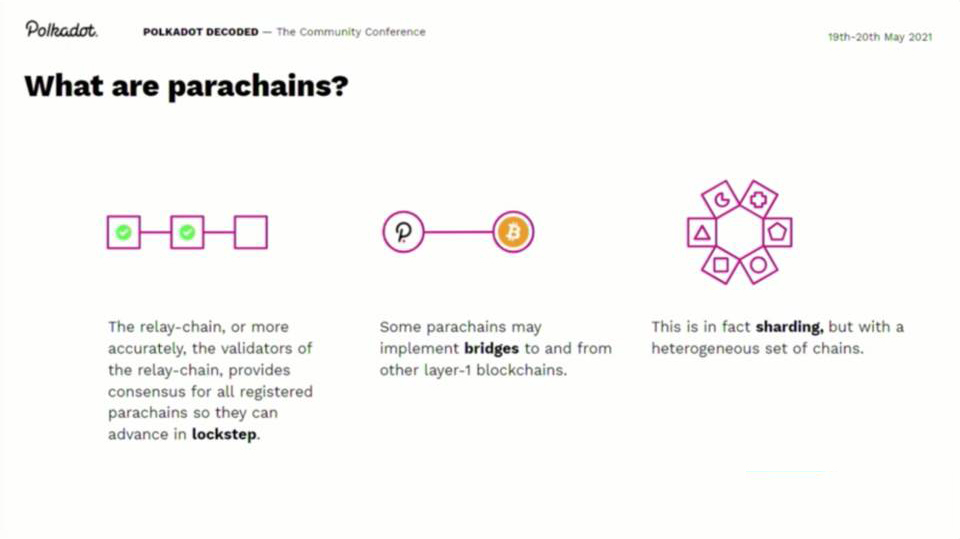
The relay chain maintains a set of parachains, and the validators of the relay chain provide consensus for all parachains so that they can move forward at a consistent pace. We randomly assign validators across all relay chains to check different parachains.
So here we are talking about splitting validators to all parachains, which is actually very similar to the concept of sharding that we have heard before. The main difference is that Polkadot is a set of heterogeneous chains rather than isomorphic chains, so each chain can do different things and have different state transition functions.
parallel threads
parallel threads
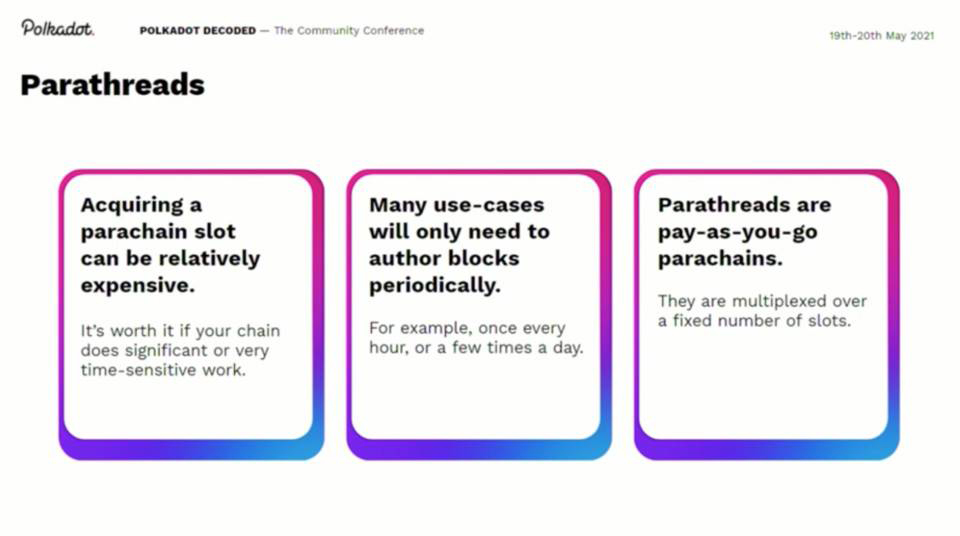
Parathreads are a slightly different version of parachains.
When you get a parachain slot, it is a one-time auction for several months or years, and you will compete with the global parachain community for slots. It's worth doing this if your chain does work that is particularly time-sensitive. But for many long-tail projects, this is too expensive.
A parachain is a “pay as you go” parachain. We have some fixed number of slots reserved exclusively for parathreads. Say there are five slots for parathreads, maybe 500 or 5000 chains competing to create blocks on those slots.
secondary title
Parachains are tools
Types of Parachains
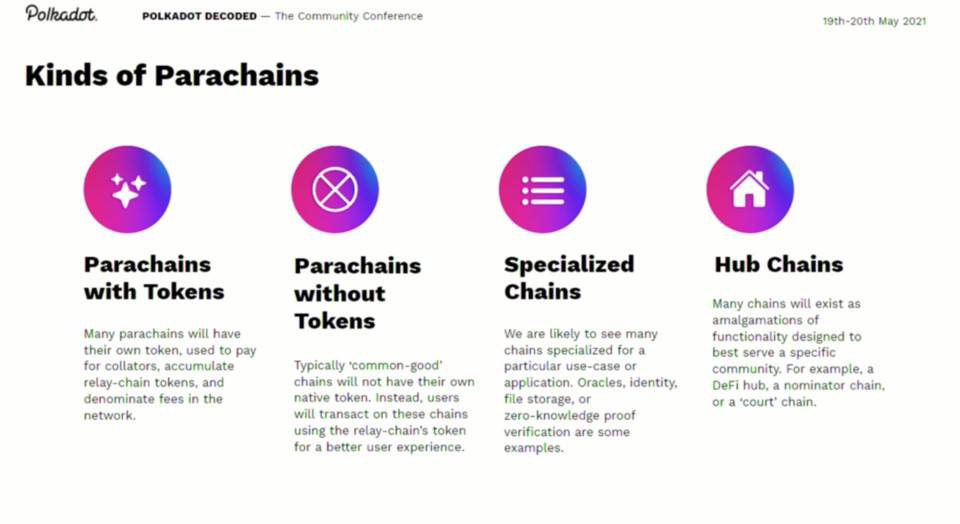
Parachains can come in many varieties. For example, parachains with coins, parachains without coins (such as public goods parachains), parachains specialized in a certain field (such as oracles, identities, file storage, zero-knowledge proofs, etc.), services for a certain community Hub chains (such as DeFi hubs, governance hubs, etc.).
For example, smart contract parachains. You can have a parachain that allows people to execute smart contracts, either ink! contracts or traditional EVM Solidity contracts. I am used to classifying smart contract parachains as general-purpose professional chains. It allows people to run smart contracts, which provides a lot of flexibility, but also has the disadvantages of smart contracts.
But luckily you have a choice. You can write a parachain yourself, or use smart contracts.
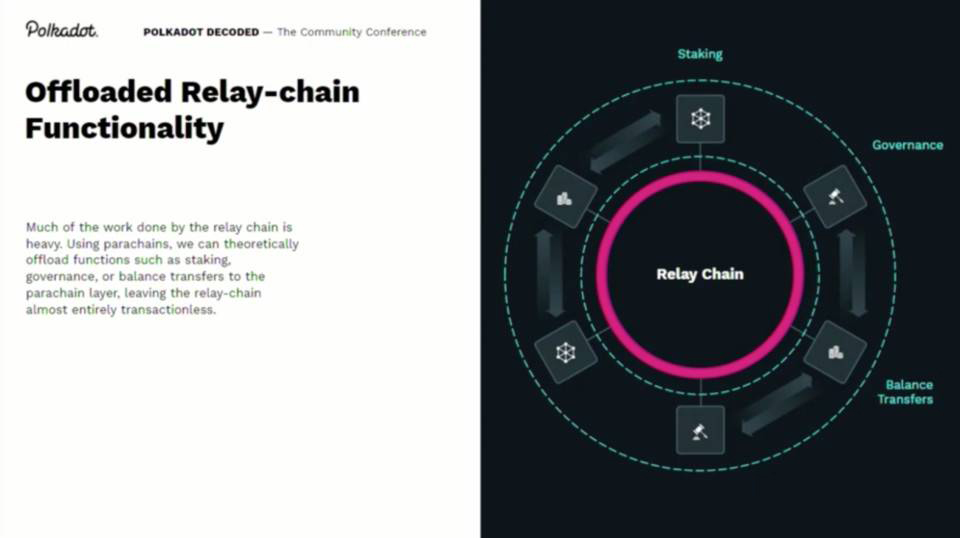
The parallel chain will share part of the functions of the relay chain
The current relay chain undertakes many functions. Later, some functions of the relay chain, such as staking, governance, transfer, etc., can be transferred to the parallel chain, and the relay chain is only responsible for the consensus of the parallel chain. This will liberate the computing resources of the relay chain, making the relay chain the first blockchain without transactions, and only need to focus on the parachain consensus, thereby expanding the scale of the parachain as much as possible.
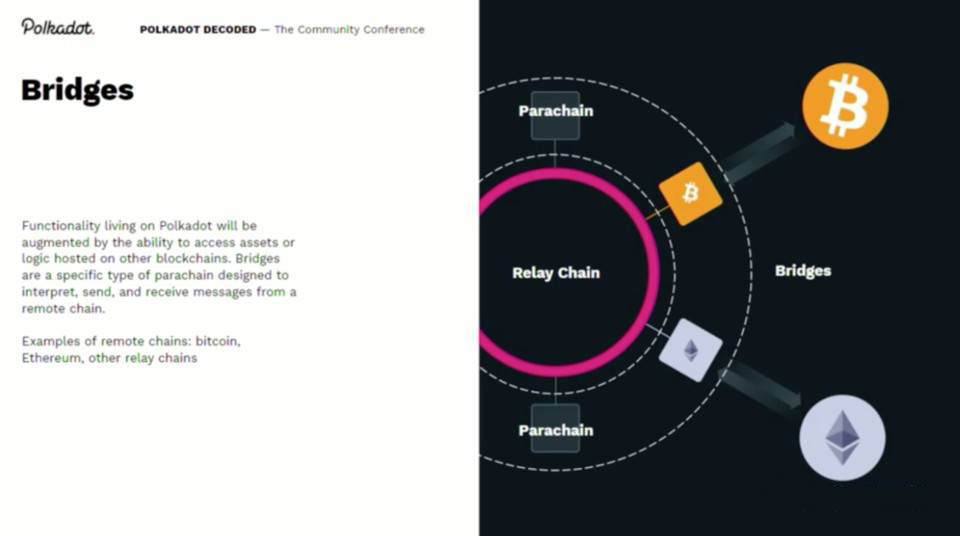
Bitcoin and Ethereum will not disappear in the short term. We hope that applications on Polkadot can use Bitcoin assets and projects on Ethereum. At present, bridge-related research and development are in progress, and will eventually be deployed on Polkadot, connecting Polkadot with Bitcoin and Ethereum through the parallel chain mechanism.
secondary title
Parachains are organizations
Parachains represent a collection of financial assets and social assets.
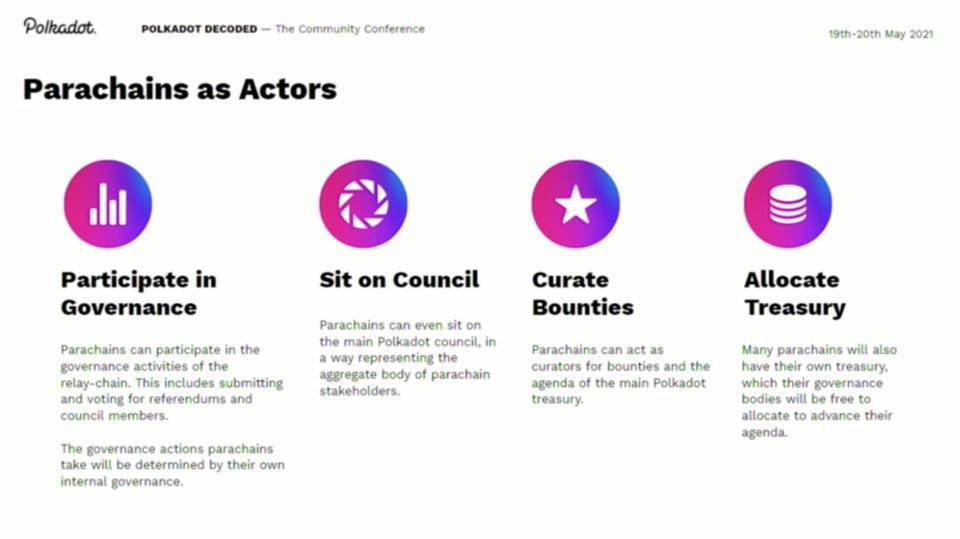
Parachains are actors
Each parachain can perform many activities as an actor on behalf of its stakeholders, such as participating in the governance of the relay chain through proposals and voting, becoming a member of the Polkadot network council, managing bounty tasks, allocating treasury funds, etc.
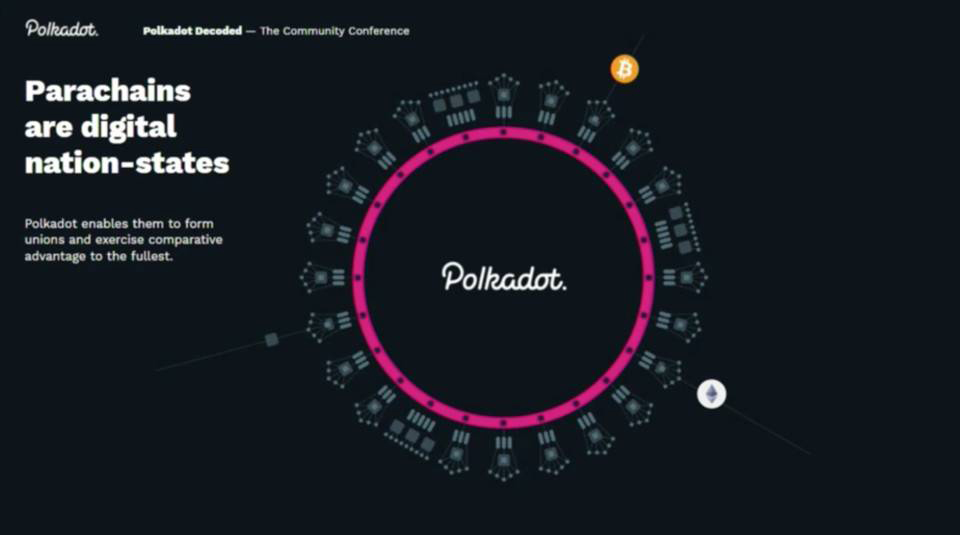
Parachains are like digital countries, and each country has its own comparative advantages. Polkadot's XCMP allows parallel chains to interact, just like countries can conduct international trade.
secondary title
Parachains are software
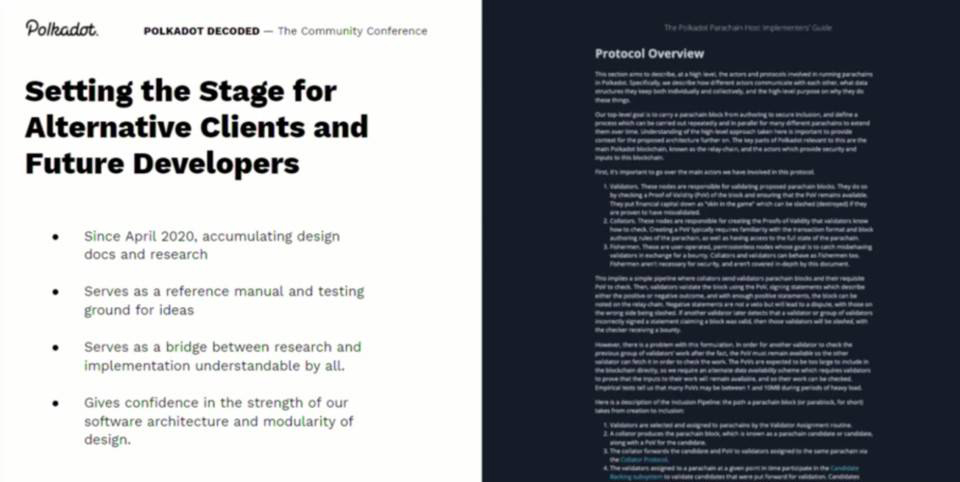
Set the stage for multiple clients and developers
At the beginning of 2020, we made the "Guidelines for Polkadot Parachain Host Implementers", which is a bridge between research and development, and a specification that allows researchers to know what developers are doing, and developers to know the lower level of research details.
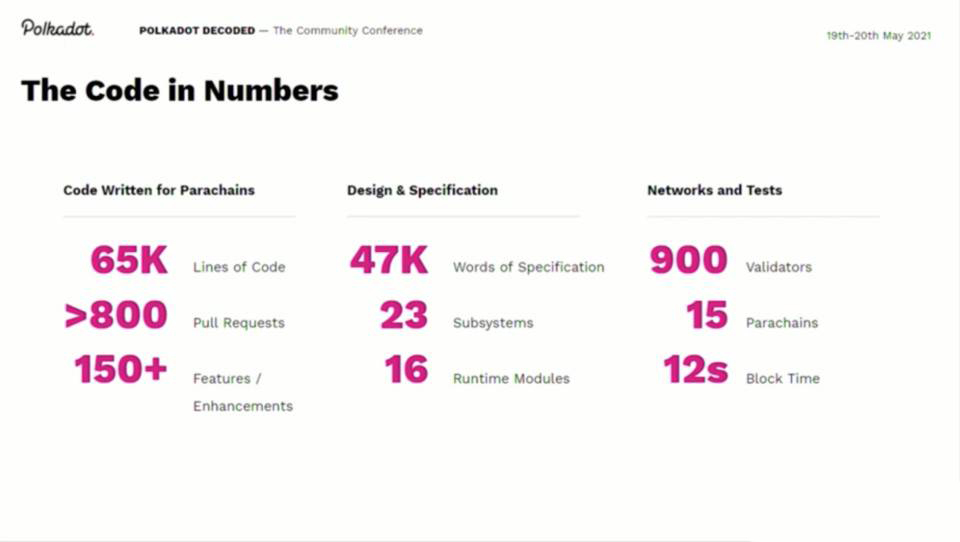
code data
In terms of code, in the past year and a half, we have written 65,000 lines of code related to the parachain alone. It includes the Parachain Runtime module, Parachain network code, and Parachain execution code. There are also 800+ PRs, 150+ features and enhancements.
In terms of design and standards, a standard of more than 47,000 words, 23 subsystems responsible for different modules, and 16 runtime modules were written.
In terms of network and testing, we have 900 validators on Rococo, run 15 blockchains, and achieved a block time of 12 seconds. In fact, the code on the chain can already achieve a block generation time of 6 seconds, but the code under the chain still needs to be optimized.
What has happened since Polkadot Decoded last December?
Rococo testnet launched (900 validators, 15 parachains, cross-chain asset transfer using XCMP-lite)
Completed shard security protocol and code base audit
Launched Westend perma-testnet
Added 16 runtime modules to Kusama
Added code for parachains, crowdlending and auctions to Kusama
Added the first parachain Shell to Kusama (upgraded to Statemine soon)
What's next?
What's next?
Auction of 5 Kusama parachains will be held (the specific time has not been announced yet, it will be conducted after the parachains are running stably on Kusama)
Launch public goods parachain and community parachain
complete audit
Add parachain, crowd lending, and auction module codes to Polkadot (theoretically, if the parachain works well on Kusama, it will work well on Polkadot as well)
Start rolling out parachains on Polkadot
Optimize and scale with a target of 50 parachains and 1000 validators



